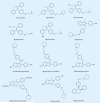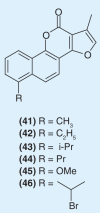Development of new estrogen receptor-targeting therapeutic agents for tamoxifen-resistant breast cancer
- PMID: 23734685
- PMCID: PMC3855007
- DOI: 10.4155/fmc.13.63
Development of new estrogen receptor-targeting therapeutic agents for tamoxifen-resistant breast cancer
Abstract
Despite our deepening understanding of the mechanisms of resistance and intensive efforts to develop therapeutic solutions to combat resistance, de novo and acquired tamoxifen resistance remains a clinical challenge, and few effective regimens exist to treat tamoxifen-resistant breast cancer. The complexity of tamoxifen resistance calls for diverse therapeutic approaches. This review presents several therapeutic strategies and lead compounds targeting the estrogen receptor signaling pathways for treatment of tamoxifen-resistant breast cancer, with a critical assessment of challenges and potentials regarding clinical outcome. Medicinal chemistry holds the key to effective, personalized combination therapy for tamoxifen-resistant breast cancer by making available a diverse arsenal of small-molecule drugs that specifically target signaling pathways modulating hormone resistance. These combination therapy candidates should have the desired specificity, selectivity and low toxicity to resensitize tumor response to tamoxifen and/or inhibit the growth and proliferation of resistant breast cancer cells.
Figures








References
-
- Forouzanfar MH, Foreman KJ, Delossantos AM, et al. Breast and cervical cancer in 187 countries between 1980 and 2010: a systematic ana lysis. Lancet. 2011;378(9801):1461–1484. - PubMed
-
- Harvey JM, Clark GM, Osborne CK, Allred DC. Estrogen receptor status by immunohistochemistry is superior to the ligand-binding assay for predicting response to adjuvant endocrine therapy in breast cancer. J. Clin. Oncol. 1999;17(5):1474–1474. - PubMed
-
- Fan P, Wang J, Santen Rj, Yue W. Long-term treatment with tamoxifen facilitates translocation of estrogen receptor α out of the nucleus and enhances its interaction with EGFR in MCF-7 breast cancer cells. Cancer Res. 2007;67(3):1352–1360. - PubMed
-
- Rao RD, Cobleigh MA. Adjuvant endocrine therapy for breast cancer. Oncology. 2012;26(6):541–547. - PubMed
-
- Jordan VC, O’Malley BW. Selective estrogen-receptor modulators and antihormonal resistance in breast cancer. J. Clin. Oncol. 2007;25(36):5815–5824. - PubMed
■ Websites
-
- WHO The global burden of disease: 2004 update. www.who.int/healthinfo/global_burden_disease/2004_report_update/en/index....
-
- National Cancer Institute at the NIH: breast cancer. www.cancer.gov/cancertopics/types/breast.
-
- American Cancer Society: cancer facts and figures 2013. www.cancer.org/research/cancerfactsfigures/acspc-036845.
-
- National Cancer Institute: cancer advance in focus: breast cancer. www.cancer.gov/cancertopics/factsheet/cancer-advances-in-focus/breast.
Publication types
MeSH terms
Substances
Grants and funding
LinkOut - more resources
Full Text Sources
Other Literature Sources
Medical
